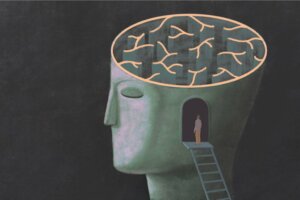Thinking Traps: What They Are and How to Detect Them


Written and verified by the psychologist Valeria Sabater
Thinking traps are negative reasoning patterns. You can imagine them as labyrinths in which your common sense and your ability to see things with perspective, in a logical and calm way, become trapped. Instead, cognitive distortions and emotional filters triumph, fueling your unhappiness.
Everyone has experienced these kinds of mental phenomena at some time or another. They tend to indicate that, as a human being you’re a rational creature. Nevertheless, this image doesn’t really fit in with reality. Because, as a human being, you’re an emotional creature who reasons. In fact, it’s your emotions that dominate your way of thinking and acting.
Sometimes you don’t recognize that you’re to blame for your unhappiness. Because your mind isn’t always objective or logical, and you often drift into a self-destructive spiral. Let’s take a closer look.
“There are three musts that hold us back. I must do well. You must treat me well. And the world must be easy.”
-Albert Ellis-

Thinking traps
Thinking traps are present in almost any scenario, including emotional relationships. In fact, in this area, biased and distorted ideas tend to become dominant, preventing you from escaping painful ties.
The University of North Carolina (USA) conducted research that claimed that cognitive distortions in many young people lead to dating violence. Thus, addressing these distortions would improve both their mental health and human potential.
Your ability to be happy and maintain satisfying relationships depends largely on detecting and intervening in your thinking traps. Let’s take a look at the most common and exhausting.
Labeling and judging yourself
“I’m useless” “I’m stupid” “I just can’t do it”. One of the most common thinking traps is to assign yourself a qualifying adjective each time reality contradicts your wishes. Indeed, you make a quick judgment without even analyzing what led you into the situation. Furthermore, you don’t view yourself in a respectful or compassionate way.
“Insecure people like me get nowhere in life”. These kinds of thoughts define labeling, an extremely common and disabling trap for your self-esteem.
Personalizing
“My partner’s come home from work really irritable. It’s because he doesn’t really want to be with me” ,“My boss has been really stressed today. I must’ve done something wrong”, “My friend’s yawning. I must be boring them”. Sometimes, you place realities on yourself that are completely alien to you. Personalizing is a useless way to torture yourself by believing that you’re the reason and origin of everything that happens around you.
Overgeneralizing and catastrophic thinking
“If I have another anxiety attack, I’ll die”, “I’m going to get sacked, then I won’t be able to pay the mortgage and I’ll lose the house”. Overgeneralization appears when you take it for granted that a negative event will bring with it a whole chain of catastrophes.
Filtering
Filtering is another of the most common thinking traps. It means you only pay attention to the negative aspects of everyday life while ignoring all the positives. It doesn’t matter that things start to get better, your mind only captures the adverse and the troublesome.
The tyranny of musts and shoulds
The entire list of thinking traps or cognitive distortions was first given to us by Albert Ellis and later expanded on by the psychotherapist Aaron T. Beck. However, Ellis was the first who alerted us to the tyranny of the ‘musts’ and ‘shoulds’.
The “I must” and the “I should`”make rigid and demanding rules that your mind creates to remind you how (according to it) most things should be. Getting out of these schemes is intolerable, and makes you feel fallible or useless.
An example of this is thinking that your partner should be this way or that way. Also, that life should be easier and you should be much more skilled and productive.
Emotional reasoning
This type of thinking trap hijacks your rational mind and it becomes dominated by negative valence emotions. Emotions such as anger, sadness, and disappointment. These make you process the world through these emotional states.
Emotional reasoning causes you to fall into endless loops of suffering. For example, if you think of something negative, you feel bad and because you feel bad, you see reality through a lens of doom. Then, you reinforce your fear much more, and your mind is captivated by this tricky focus.

How to deactivate these kinds of thoughts
The most important thing in these cases is to be aware that everyone reinforces and falls into their own thinking traps. Indeed, no one is immune to these types of cognitive devices that bring discomfort and suffering. Knowing that they exist is essential. However, deactivating them is a slightly more complex task. That’s because, as a rule, you’ve been reinforcing them for years.
Cognitive-behavioral therapy (CBT) uses an extremely effective resource in these situations. This is cognitive restructuring. This therapy helps you to work through your thoughts, emotions, and behaviors in order to facilitate control of your life and regain a sense of well-being.
Thinking traps are negative reasoning patterns. You can imagine them as labyrinths in which your common sense and your ability to see things with perspective, in a logical and calm way, become trapped. Instead, cognitive distortions and emotional filters triumph, fueling your unhappiness.
Everyone has experienced these kinds of mental phenomena at some time or another. They tend to indicate that, as a human being you’re a rational creature. Nevertheless, this image doesn’t really fit in with reality. Because, as a human being, you’re an emotional creature who reasons. In fact, it’s your emotions that dominate your way of thinking and acting.
Sometimes you don’t recognize that you’re to blame for your unhappiness. Because your mind isn’t always objective or logical, and you often drift into a self-destructive spiral. Let’s take a closer look.
“There are three musts that hold us back. I must do well. You must treat me well. And the world must be easy.”
-Albert Ellis-

Thinking traps
Thinking traps are present in almost any scenario, including emotional relationships. In fact, in this area, biased and distorted ideas tend to become dominant, preventing you from escaping painful ties.
The University of North Carolina (USA) conducted research that claimed that cognitive distortions in many young people lead to dating violence. Thus, addressing these distortions would improve both their mental health and human potential.
Your ability to be happy and maintain satisfying relationships depends largely on detecting and intervening in your thinking traps. Let’s take a look at the most common and exhausting.
Labeling and judging yourself
“I’m useless” “I’m stupid” “I just can’t do it”. One of the most common thinking traps is to assign yourself a qualifying adjective each time reality contradicts your wishes. Indeed, you make a quick judgment without even analyzing what led you into the situation. Furthermore, you don’t view yourself in a respectful or compassionate way.
“Insecure people like me get nowhere in life”. These kinds of thoughts define labeling, an extremely common and disabling trap for your self-esteem.
Personalizing
“My partner’s come home from work really irritable. It’s because he doesn’t really want to be with me” ,“My boss has been really stressed today. I must’ve done something wrong”, “My friend’s yawning. I must be boring them”. Sometimes, you place realities on yourself that are completely alien to you. Personalizing is a useless way to torture yourself by believing that you’re the reason and origin of everything that happens around you.
Overgeneralizing and catastrophic thinking
“If I have another anxiety attack, I’ll die”, “I’m going to get sacked, then I won’t be able to pay the mortgage and I’ll lose the house”. Overgeneralization appears when you take it for granted that a negative event will bring with it a whole chain of catastrophes.
Filtering
Filtering is another of the most common thinking traps. It means you only pay attention to the negative aspects of everyday life while ignoring all the positives. It doesn’t matter that things start to get better, your mind only captures the adverse and the troublesome.
The tyranny of musts and shoulds
The entire list of thinking traps or cognitive distortions was first given to us by Albert Ellis and later expanded on by the psychotherapist Aaron T. Beck. However, Ellis was the first who alerted us to the tyranny of the ‘musts’ and ‘shoulds’.
The “I must” and the “I should`”make rigid and demanding rules that your mind creates to remind you how (according to it) most things should be. Getting out of these schemes is intolerable, and makes you feel fallible or useless.
An example of this is thinking that your partner should be this way or that way. Also, that life should be easier and you should be much more skilled and productive.
Emotional reasoning
This type of thinking trap hijacks your rational mind and it becomes dominated by negative valence emotions. Emotions such as anger, sadness, and disappointment. These make you process the world through these emotional states.
Emotional reasoning causes you to fall into endless loops of suffering. For example, if you think of something negative, you feel bad and because you feel bad, you see reality through a lens of doom. Then, you reinforce your fear much more, and your mind is captivated by this tricky focus.

How to deactivate these kinds of thoughts
The most important thing in these cases is to be aware that everyone reinforces and falls into their own thinking traps. Indeed, no one is immune to these types of cognitive devices that bring discomfort and suffering. Knowing that they exist is essential. However, deactivating them is a slightly more complex task. That’s because, as a rule, you’ve been reinforcing them for years.
Cognitive-behavioral therapy (CBT) uses an extremely effective resource in these situations. This is cognitive restructuring. This therapy helps you to work through your thoughts, emotions, and behaviors in order to facilitate control of your life and regain a sense of well-being.
All cited sources were thoroughly reviewed by our team to ensure their quality, reliability, currency, and validity. The bibliography of this article was considered reliable and of academic or scientific accuracy.
- Miller, A. B., Williams, C., Day, C., & Esposito-Smythers, C. (2017). Effects of Cognitive Distortions on the Link Between Dating Violence Exposure and Substance Problems in Clinically Hospitalized Youth. Journal of clinical psychology, 73(6), 733–744. https://doi.org/10.1002/jclp.22373
- Rnic, K., Dozois, D. J., & Martin, R. A. (2016). Cognitive Distortions, Humor Styles, and Depression. Europe’s journal of psychology, 12(3), 348–362. https://doi.org/10.5964/ejop.v12i3.1118
- Ruiz, M. A., DIíaz, M. I. & Villalobos, A. (2012). Manual de Técnicas de Intervención Cognitivo Conductuales. Bilbao: Desclée De Brouwer
This text is provided for informational purposes only and does not replace consultation with a professional. If in doubt, consult your specialist.







